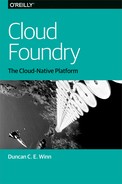Book Description
This O’Reilly report explains the capabilities of cloud-native platforms and examines the fundamental changes enterprises need to make in process, organization, and culture if they’re to take real advantage of this approach.
Author Duncan Winn focuses on the open source platform Cloud Foundry. You’ll learn how cloud-native applications are designed to be "infrastructure unaware" so they can thrive and move at will in the highly distributed and constantly evolving cloud environment.
You’ll explore:
- Technical driving forces that are rapidly changing the way organizations develop and deliver software today
- How key concepts underpinning the Cloud Foundry platform leverage each of the technical forces discussed
- How cloud-native platforms remove the requirement to perform undifferentiated heavy lifting, such as provisioning VMs, middleware, and databases
- Why cloud-native platforms enable fast feedback loops as you move from agile development to agile deployment
- Recommended changes and practical considerations for organizations that want to build cloud-native applications
